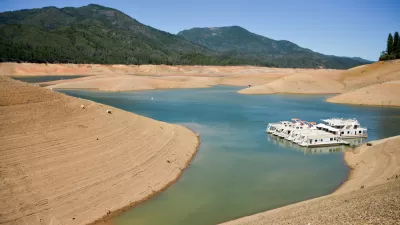As General Manager of the Metropolitan Water District of Southern California, Jeff Kightlinger is a veteran of the states' wet and dry cycles.
With increased public attention focused on every water drop during the worst drought in California's history, Kightlinger is particularly well equipped to dispel rumors and share the regional initiatives underway. He recently spoke with VerdeXchange News to update readers on how suppliers are adjusting to the changing conditions as state and local bodies further regulate use.
Kightlinger comments on alternative options for meeting the regions' supply needs, including desalination and stormwater capture. He also notes that despite potential conflict over water sources between urban and rural areas, ultimately collaboration—and an agreement to share the burden of behavioral change—will be necessary to get to goal:
"There’s no winner in this drought. Agriculture in the Central Valley has been hit extremely hard. Last year, we had more than half a million acres of farmland fallowed—over a $2 billion hit to the agricultural economy. By all accounts, 2015 will shape up much worse than that—probably three quarters of a million acres, perhaps more, fallowed. You’re seeing big disruption in the agricultural sector, just like you’re seeing in the urban sector now, with the governor ordering mandatory rationing among urban users at a 25 percent level. That’s going to be a very painful cut to urban users, as well. We’re seeing a 'share-the-pain' approach across the state."
FULL STORY: Metropolitan Water District’s Jeff Kightlinger Adopts ‘Share The Pain’ Approach To California’s Drought

Planetizen Federal Action Tracker
A weekly monitor of how Trump’s orders and actions are impacting planners and planning in America.

Chicago’s Ghost Rails
Just beneath the surface of the modern city lie the remnants of its expansive early 20th-century streetcar system.

San Antonio and Austin are Fusing Into one Massive Megaregion
The region spanning the two central Texas cities is growing fast, posing challenges for local infrastructure and water supplies.

Since Zion's Shuttles Went Electric “The Smog is Gone”
Visitors to Zion National Park can enjoy the canyon via the nation’s first fully electric park shuttle system.

Trump Distributing DOT Safety Funds at 1/10 Rate of Biden
Funds for Safe Streets and other transportation safety and equity programs are being held up by administrative reviews and conflicts with the Trump administration’s priorities.

German Cities Subsidize Taxis for Women Amid Wave of Violence
Free or low-cost taxi rides can help women navigate cities more safely, but critics say the programs don't address the root causes of violence against women.
Urban Design for Planners 1: Software Tools
This six-course series explores essential urban design concepts using open source software and equips planners with the tools they need to participate fully in the urban design process.
Planning for Universal Design
Learn the tools for implementing Universal Design in planning regulations.
planning NEXT
Appalachian Highlands Housing Partners
Mpact (founded as Rail~Volution)
City of Camden Redevelopment Agency
City of Astoria
City of Portland
City of Laramie



























